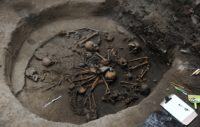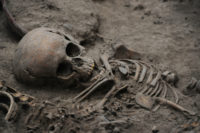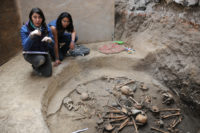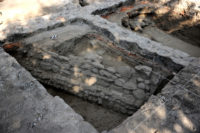 Archaeologists with Mexico’s National Institute of Anthropology and History (INAH) have discovered a 2,500-year-old grave containing the skeletal remains of at least 10 people during a salvage excavation in Tlalpan, a borough in the Federal District of Mexico City. The grave was found five feet below the surface under property belonging to the Pontifical University of Mexico. It is the first burial with so many individuals from the Preclassic period found in the Valley of Mexico. Previous finds have had two, at most three, individuals buried together.
Archaeologists with Mexico’s National Institute of Anthropology and History (INAH) have discovered a 2,500-year-old grave containing the skeletal remains of at least 10 people during a salvage excavation in Tlalpan, a borough in the Federal District of Mexico City. The grave was found five feet below the surface under property belonging to the Pontifical University of Mexico. It is the first burial with so many individuals from the Preclassic period found in the Valley of Mexico. Previous finds have had two, at most three, individuals buried together.
 The burial pit is modest in size, about 6.5 feet in diameter, considering how many bodies it contains. The skeletons found there were all buried at the same time. So far 10 individual skeletons have been identified. The sex of three of them has been determined — two female, one male — and archaeologists are working to identify the rest. Most of them were children at the time of death. There is one confirmed adult, one child between three and five years of age and the remains of an infant who died just one month old. Osteological analysis has found individuals with deliberate cranial deformation and some dental modifications as well. There are also evidence of wear on the teeth and bone spurs on the vertebrae, today more common in people older than 50.
The burial pit is modest in size, about 6.5 feet in diameter, considering how many bodies it contains. The skeletons found there were all buried at the same time. So far 10 individual skeletons have been identified. The sex of three of them has been determined — two female, one male — and archaeologists are working to identify the rest. Most of them were children at the time of death. There is one confirmed adult, one child between three and five years of age and the remains of an infant who died just one month old. Osteological analysis has found individuals with deliberate cranial deformation and some dental modifications as well. There are also evidence of wear on the teeth and bone spurs on the vertebrae, today more common in people older than 50.
The grave goods include earthenware bowls, pots and gourds of various sizes from large to tiny. There also stones and ceramic spheres placed in the hands of some of the deceased.
 Investigations into the cause of death are ongoing. There is no immediate evidence of them being related to each other or affiliated in any other way, but there is likely a ritual significance to their deaths because their remains were carefully arranged, the arms of one placed under the spine of the other in a sort of windmill pattern that is particularly pronounced in the center. They’re not in the same positions, however. Some are on their sides, others on their back or with their knees pulled up to their chest or their lower limbs hyperextended towards the hips. Their intricate placement is how the team knew they were buried together in a single event.
Investigations into the cause of death are ongoing. There is no immediate evidence of them being related to each other or affiliated in any other way, but there is likely a ritual significance to their deaths because their remains were carefully arranged, the arms of one placed under the spine of the other in a sort of windmill pattern that is particularly pronounced in the center. They’re not in the same positions, however. Some are on their sides, others on their back or with their knees pulled up to their chest or their lower limbs hyperextended towards the hips. Their intricate placement is how the team knew they were buried together in a single event.
The area was first settled around 1200-1000 BC as a small farming community. It was one of the first settlements south of modern-day Mexico City. The civic center that developed is known as Cuicuilco and the archaeological site contains the remains of a conical pyramid on oval base, built around 800–600 B.C., likely modeled after one of several active volcanoes in the Valley of Mexico. The attempt to appease the local Pele was successful for centuries. Until it wasn’t. Cuicuilco was obliterated in the eruption of the Xitle volcano around 100-200 A.D. Subsequent eruptions buried the city and the valley in lava.
The village of Tlalpan was settled just east of Cuicuilco between the Zacatenco phases (700-400 B.C.) and Ticoman (400-200 B.C.) of the Middle and Late Formative period. It had come to some prominence, apparently, until the eruption depopulation the valley. There may have been a brief Post-Classic period resettlement (archaeologists are still debating this point) but by then the area was dominated by the nearby urban center of Teotihuacan which didn’t exist yet as a single community when Xitle destroyed Cuicuilco.
 When archaeologists first came across the remains of basalt stone walls, they weren’t sure at first what period they came from. They thought they might be Post-Classic, but closer examination found that they were built using river stones, which is marker of Pre-Classic construction. INAH experts believe Tlalpan had areas used for residential, ritual or burial purposes, pieces of which have been found in this excavation and others over the past dozen years. The stone walls were from a private dwelling, archaeologists believe.
When archaeologists first came across the remains of basalt stone walls, they weren’t sure at first what period they came from. They thought they might be Post-Classic, but closer examination found that they were built using river stones, which is marker of Pre-Classic construction. INAH experts believe Tlalpan had areas used for residential, ritual or burial purposes, pieces of which have been found in this excavation and others over the past dozen years. The stone walls were from a private dwelling, archaeologists believe.
This Spanish language video released by INAH shows the burial pit once it’s fully excavated and includes commentary from the researchers on the arrangement of the bodies. Turn on the closed captioning if your Spanish is shaky or non-existent and use the auto-translator to get a hint of what they’re saying through the autogenerated weirdnesses.
That is not to say it was not some creepy killer’s art project… 😮
Hello, I am a photo editor at The Washington Post. I would like to get help with permission for using these images on our site. Can you provide any information to get permission for the images? Thank you, Wendy
It so shocking and horrible after seeing these things,2500 years ago the humans are buried together in same burial,it means it was so horrible for those buried peoples.
Fantastic article! So interesting!